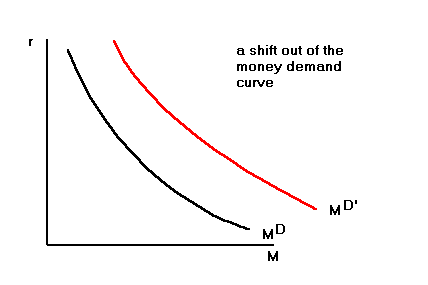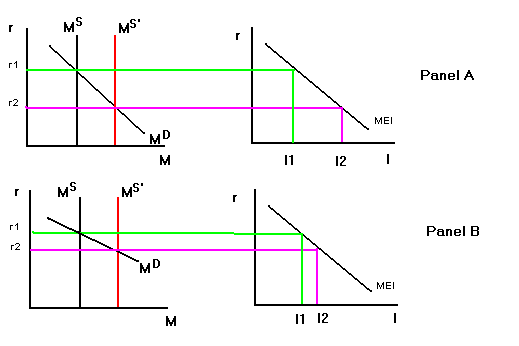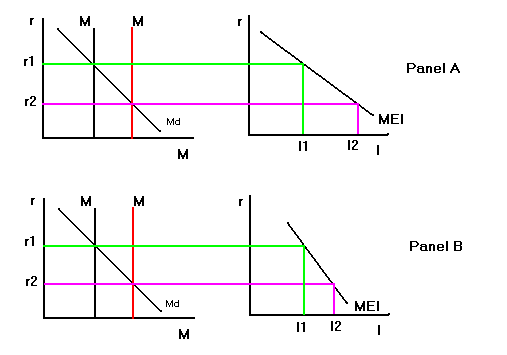
The money creation is only one part of how the money supply can affect the economy. As in most markets, there is a demand side of the market that determines price along with the supply side. The price of money is the interest rate. When you borrow or hold money, you are paying the interest rate either directly or as an opportunity cost. When holding money, you give up the possibility of lending it - to someone or in a savings account - and thus give up the chance to earn interest.
Money is just like any commodity. It is traded in a market, with "sellers" supplying and "buyers" demanding it. The seller of money is the Federal Reserve System, which (as we'll see below) sets the money supply. The demanders of money are individuals, firms and institutions, who use it for making transactions, as a precaution against unforeseen needs, and as part of an overall investment strategy.
Money demand is also called liquidity preference. We noted three uses for money, and linked to these uses are three types of money demand:
Transactions balances is money held so purchases can be made easily. We might keep a couple of hundred dollars in a checking account for use in our day-to-day spending.
Precautionary balances is money held against unforeseen expenses or situations. So we keep a few thousand dollars liquid (as money or demand deposits, rather than as stocks or certificates of deposits) in case we lose our job, our car breaks, or we need an emergency visit somewhere.
Speculative balances is money held as part of an investment plan. If we are afraid of drops in the stock and bond markets, we might hold part of our money as cash (or money market funds).
All three of these types of money demand are negatively related to the interest rate. For transactions balances and speculative balances, if the interest rate goes up, our opportunity cost of holding money goes up as well. Thus, we'll hold less of it. For speculative balances, the opportunity cost argument holds, but there is more. When interest rates go up, stocks and bonds both tend to fall in price. When the interest rate is very low, there is a reasonable chance that the interest rate will go up. Investors might think that stock and bond prices will fall in the future, so they will move into cash. Low interest rate means high cash balances. But if the interest rate is high, there is a good chance it will fall soon, and stocks and bonds will increase in price. Investors move out of cash and into stocks and bonds.
National income (wealth) also affects the demand for money. All three types of balances are apt to be higher if NI is high, simply because wealthier people have more wealth to hold in the form of money. Thus, we see MD is negatively related to the interest rate, but positively related to NI.
We graph this relationship by

In the graph, the NI that generates MD is smaller than the NI that supports MD'.
Money supply (MS) is set by the Federal Reserve System. Later we will explore how that is done. For now, just take it as given, and realize that since the Fed sets MS, we can take it as a vertical line. Then, equilibrium is found as in any other market - by the intersection of supply and demand.

As in any other market, shifts in supply and demand affect the equilibrium price. If something increases the demand for money (MD shifts to the right) equilibrium interest rate falls. Since MS is vertical, the quantity of money is unchanged.

Shifts in the money supply change both the interest rate and the quantity of money. If MS shifts to the right, the interest rate will fall, and of course the amount of money goes up.

We've seen how changes in the money supply affects the equilibrium interest rate, but how does that affect the economy. The key here is through planned investment (I) - and is called the transmission mechanism. Firms make an investment if it will make a profit. One part of cost is the opportunity cost of money - the interest rate - either from borrowing money from banks or because the firm could have put the money into the bank and earned interest. Thus, if the interest rate goes up, the firm is less likely to make a profit on an investment (since the cost of the investment has gone up), and so the firm will make fewer investments. We've established a negative relationship between the interest rate and the amount of planned investment - which is called the marginal efficiency of investment (MEI).

As we can see in the graph, the interest rate is determined in the money market (left panel) which then determines investment (right panel). If the money supply is cut, the interest rate increases, and the amount of planned investment falls. This means that the aggregate expenditure (AE) curve shifts down, and as a result the aggregate demand curve (AD) shifts to the left, as shown below.

Before moving on, let's look at the relationship between the money supply (M1) and investment:

Notice how M1 and investment move together.
We have now shown that the money supply controls the interest rate, which affects planned investment, which shifts the AD curve. So what does all this mean for NI?
We go back to our analysis of equilibrium in the aggregate demand - aggregate supply model.

Suppose the money supply increases, thus so does planned investment. The AD curve shifts to the right, creating an inflationary gap. As we know, that means higher prices and NI in the short run, but in the long run the SAS shifts to close the gap, and we get only higher prices. Thus, we see that the quantity theory of money (see above) holds in the long run. Money is said to be neutral (on NI) in the long run, but not in the short run.
As an exercise, work out the changes if the money supply decreases. What gains might the economy see, if any?
Money supply impacts the economy by changing the interest rate, which in turn changes investment, thus shifting AD. We see short run effects on NI and the price level, and long run effects only on the price level. How much a change in the money supply will change AD depends on the slopes of the money demand curve and the MEI.
First, let's look at the importance of the slope of the money demand curve.

The top panel (panel A) shows a relatively steep money demand curve. A change in money supply has a big (downward) effect on interest rates. This causes a fairly large increase in investment (look at the MEI curve) and the AD curve would shift out quite a bit.
Contrast that to the bottom panel (panel B). The money demand curve is flat, so the same change in the money supply causes only a small drop in the interest rate. When this is translated into an increase in investment, the effect is much smaller, and so there would be a relatively small shift to the right of the AD curve.
The next set of pictures looks at the importance of the slope of the MEI curve.

In the top panel the MEI is rather flat, so investment is very
responsive to changes in the interest rate. But in the lower panel
(panel B) the MEI is steep. Even if the interest rate changes
a lot, investment changes only a little. Monetary changes have
much more influence when the MEI is flat than when the MEI is
steep.